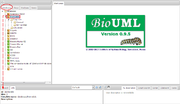Databases
| This page or section is a stub. Please add more information here! |
Close integration with biological databases containing experimental data is a distinctive feature of BioUML, which is essential for accurate and convenient modeling of biological systems. For the purpose of working with different kinds of data the database type concept has been introduced. The database type defines:
- data types (gene, protein, RNA, substance, reaction, etc.) that are stored in the database;
- mapping of the database content into diagram elements and diagram types that can be used with the database;
- diagram types that can be used to present the database content as a set of diagrams;
- the query engine to find interacting components of the system; search results can be shown as a graph and edited by the user.
According to their content (data type) biological databases can be divided into several groups as follows (one database can provide several types of data; the green colour indicates that the database is freely available in BioUML web edtion):
| Data type | |||||
| pathways | gene/protein classification | genome | pathways simulation | transcription factor | |
| Apoptosis model | + | ||||
| Biomodels | + | ||||
| Biopath | + | ||||
| Ensemble | + | ||||
| Geneways | + | ||||
| GO | + | ||||
| GTRD | + | + | |||
| HumanCyc | + | + | |||
| KEGG | + | ||||
| Proteome (Biobase) | + | ||||
| Reactome | + | + | |||
| Transfac (Biobase) | + | ||||
| TRANSPath (Biobase) | + | + | |||
| UCSC Genome Browser | + | ||||
| Virtual Human | + | ||||
Databases can be installed locally (for the BioUML workbench) or can be accessed via the Internet from the BioUML server, which supports secure access to databases. The server administrator can configure security settings for access to each database installed on the server. The information where a database is installed (locally or on the server side) as well as about its availability is displayed using different icons.
Interface
All the available databases are listed under the Databases tab in the repository pane. The icon color indicates location and accessibility of the database:
- blue color - the database is installed locally, accessible for reading and writing:
- yellow - remote public database, accessibility for reading and writing is specified by R and W letters:
- red color - remote protected database, the user must log-in to get access to the database, accessibility for reading and writing is specified by R and W letters:
- green color - remote protected database, the user successfully logged in, accessibility for reading and writing is specified by R and W letters:
Databases are handled like any other data collection in the repository pane with the exception that databases cannot be removed. When a database is selected its description is displayed in the property inspector below.
